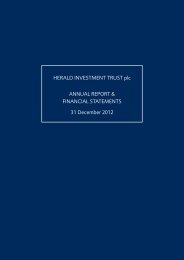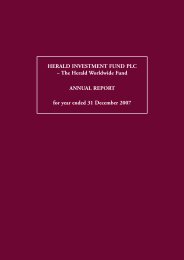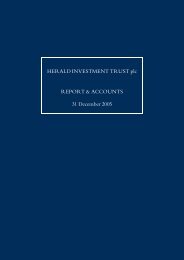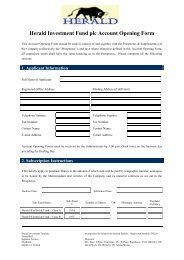HERALD INVESTMENT TRUST plc ANNUAL REPORT ...
HERALD INVESTMENT TRUST plc ANNUAL REPORT ...
HERALD INVESTMENT TRUST plc ANNUAL REPORT ...
You also want an ePaper? Increase the reach of your titles
YUMPU automatically turns print PDFs into web optimized ePapers that Google loves.
NOTES TO THE FINANCIAL STATEMENTS continued<br />
21. Financial instruments (continued)<br />
(ii) Interest Rate Risk (continued)<br />
2010 2009<br />
Notional Fair Fair Fair Notional Fair Fair Fair<br />
contract value value value contract value value value<br />
amount assets liabilities balance amount assets liabilities balance<br />
£’000 £’000 £’000 £’000 £’000 £’000 £’000 £’000<br />
Total derivative<br />
assets/(liabilities)<br />
held for trading 50,000 49,370 (58,307) (8,937) 50,000 34,211 (40,509) (6,298)<br />
Interest rate risk sensitivity<br />
(a) Cash<br />
An increase of 100 basis points in interest rates as at 31 December 2010 would have a direct effect on net<br />
assets. Based on the position at 31 December 2010, over a full year, an increase of 100 basis points would<br />
have increased the net return on ordinary activities after taxation by £395,000 (2009 – £186,000) and would<br />
have increased the net asset value per share by 0.49p (2009 – 0.23p). The calculations are based on the<br />
cash balances as at the respective balance sheet dates and are not representative of the year as a whole.<br />
(b) Fixed rate bonds<br />
An increase of 100 basis points in bond yields as at 31 December 2010 would have decreased total net<br />
assets and total return on ordinary activities by £678,000 (2009 – £803,000) and would have decreased the<br />
net asset value per share by 0.85p (2009 – 0.99p). A decrease in bond yields would have had an equal and<br />
opposite effect. The Convertible loan stocks having an element of equity are not included in this analysis<br />
as given the nature of the businesses and the risk profile of the balance sheets they are considered to<br />
have more equity like characteristics.<br />
(c) Bank loans<br />
The effect of an increase or decrease of 100 basis points in 3 month LIBOR interest rates as at 31 December<br />
2010 on the interest cost of the bank loans and the net income return has been eliminated through a 30<br />
year floating interest rate to fixed interest rate swap. The swap generates payments or charges that offset<br />
changes in the 3 month LIBOR interest rate, so that the interest payable on the bank loans is effectively<br />
converted to a fixed rate loan at 4.8975% (2009 – 4.8975%) plus margin cost. The initial term of the swap<br />
on commencement at 30 years did not match the term of the loans, therefore, hedge accounting is not<br />
used and mark to market gains or losses on the swap are captured in the net return on ordinary activities<br />
as set out in (d) below.<br />
(d) Floating interest rate to fixed interest rate swap<br />
A decrease of 100 basis points on 30 year interest rates as at 31 December 2010 would have a direct mark<br />
to market effect on the value of the swap and net assets. Based on the position as at 31 December 2010,<br />
over a full year, a decrease of 100 basis points would have decreased the gains on investments and net<br />
return on ordinary activities after taxation by £9,617,000 (2009 – £9,059,000) and would have decreased<br />
the net asset value per share by 12.03p (2009 – 11.18p). An increase of 100 basis points would have had<br />
an equal but opposite effect.<br />
(iii) Foreign Currency Risk<br />
The Company’s reporting currency is sterling, but investments are made in overseas markets as well as the<br />
United Kingdom and the asset value can be affected by movements in foreign currency exchange rates.<br />
Furthermore many companies trade internationally both through foreign subsidiaries, and through exports.<br />
The greatest foreign currency risk occurs when companies have a divergence in currencies for costs and<br />
revenues. A much less risky exposure to currency is straight translation of sales and profits. The List of<br />
Investments on pages 16 to 20 breaks down the portfolio by geographic listing. However the location of<br />
the stock market quote only has a limited correlation to the costs, revenues and even activities of those<br />
companies, and so this note should not be regarded as a reliable guide to the sensitivity of the portfolio<br />
to currency movements. For example, the holdings in the portfolio that have suffered most from US$<br />
weakness are UK companies with dollar revenues and sterling costs.<br />
The Company does not hedge the sterling value of investments that are priced in other currencies. Overseas<br />
income is subject to currency fluctuations. The Company does not hedge these currency fluctuations<br />
because it is impossible to quantify the effect for the reasons stated above. However, from time to time<br />
the Manager takes a view by holding financial assets or liabilities in overseas currencies.<br />
<strong>HERALD</strong> <strong>INVESTMENT</strong> <strong>TRUST</strong> <strong>plc</strong> 49








